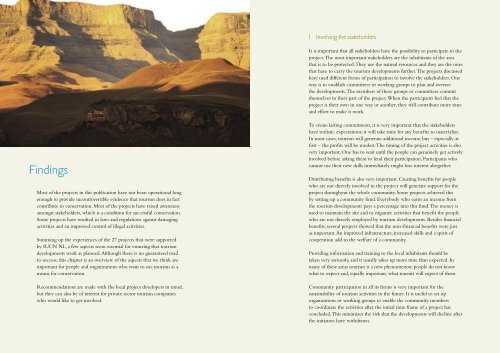OMSLAG 5.indd - IUCN
OMSLAG 5.indd - IUCN
OMSLAG 5.indd - IUCN
Create successful ePaper yourself
Turn your PDF publications into a flip-book with our unique Google optimized e-Paper software.
Findings<br />
Most of the projects in this publication have not been operational long<br />
enough to provide incontrovertible evidence that tourism does in fact<br />
contribute to conservation. Most of the projects have raised awareness<br />
amongst stakeholders, which is a condition for successful conservation.<br />
Some projects have resulted in laws and regulations against damaging<br />
activities and an improved control of illegal activities.<br />
Summing up the experiences of the 27 projects that were supported<br />
by <strong>IUCN</strong> NL, a few aspects seem essential for ensuring that tourism<br />
developments work as planned. Although there is no guaranteed road<br />
to success, this chapter is an overview of the aspects that we think are<br />
important for people and organizations who want to use tourism as a<br />
means for conservation.<br />
Recommendations are made with the local project developers in mind,<br />
but they can also be of interest for private sector tourism companies<br />
who would like to get involved.<br />
76 77<br />
1 Involving the stakeholders<br />
It is important that all stakeholders have the possibility to participate in the<br />
project. The most important stakeholders are the inhabitants of the area<br />
that is to be protected. They use the natural resources and they are the ones<br />
that have to carry the tourism developments further. The projects discussed<br />
here used different forms of participation to involve the stakeholders. One<br />
way is to establish committees or working groups to plan and oversee<br />
the developments. The members of these groups or committees commit<br />
themselves to their part of the project. When the participants feel that the<br />
project is their own in one way or another, they will contribute more time<br />
and effort to make it work.<br />
To create lasting commitment, it is very important that the stakeholders<br />
have realistic expectations: it will take time for any benefits to materialize.<br />
In most cases, tourism will generate additional income, but – especially at<br />
first – the profits will be modest. The timing of the project activities is also<br />
very important. One has to wait until the people can genuinely get actively<br />
involved before asking them to lend their participation. Participants who<br />
cannot use their new skills immediately might lose interest altogether.<br />
Distributing benefits is also very important. Creating benefits for people<br />
who are not directly involved in the project will generate support for the<br />
project throughout the whole community. Some projects achieved this<br />
by setting up a community fund. Everybody who earns an income from<br />
the tourism developments pays a percentage into this fund. The money is<br />
used to maintain the site and to organize activities that benefit the people<br />
who are not directly employed by tourism developments. Besides financial<br />
benefits, several projects showed that the non-financial benefits were just<br />
as important. An improved infrastructure, increased skills and a spirit of<br />
cooperation add to the welfare of a community.<br />
Providing information and training to the local inhabitants should be<br />
taken very seriously, and it usually takes up more time than expected. In<br />
many of these areas tourism is a new phenomenon: people do not know<br />
what to expect and, equally important, what tourists will expect of them.<br />
Community participation in all its forms is very important for the<br />
sustainability of tourism activities in the future. It is useful to set up<br />
organizations or working groups to enable the community members<br />
to coordinate the activities after the initial time frame of a project has<br />
concluded. This minimizes the risk that the developments will decline after<br />
the initiators have withdrawn.
















